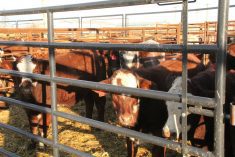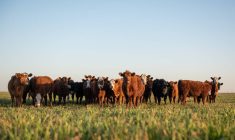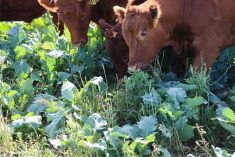Pasturing alfalfa can improve gains, but bloat is always a worry. Thankfully advancements in technology, along with pasture management, can make this a viable option.
Several principles can go a long ways to preventing unnecessary deaths when turning cattle out into leguminous pastures.
Cattle should initially be turned out in the heat of the day. This helps two things: the crop is dry with no dew (moisture greatly increases the possibility of bloat), and cattle do not graze as vigorously in the heat of the day.
Read Also

Polycrops a winning practice for Manitoba ranch
Using diverse, multispecies forage crop mixtures to feed their beef herd has dramatically improved cattle health, rancher says
Ensure they are full of dry feed before being turned out. The higher (coarser) the crop and more mature (in bloom), very much decreases the possibility of bloat. The coarser crops increase the production of saliva for digestion and saliva is a natural anti-foaming agent.
This is why you’ll hear the old-timers talking about tying a stick crossways in the mouth of a bloating animal. This resulted in tremendous chewing, saliva production and hence bloat reduction. The old-timers had a lot of common sense about them back in the day.
Once cattle are exposed to the alfalfa, leave them on it. Reintroduction can result in problems similar to what occurs after a storm in which grazing patterns have been changed. Uniform and regular intake is the key to minimizing bloat. By all means be vigilant about observation especially when first turned out.
- From Grainews: Proper mineral supplement can prevent grass tetany
Strip grazing will prevent cattle from selectively grazing rich stands, but one must also watch the regrowth, as it is much more likely to result in bloat.
There are several alternative medical preventions available for bloat on pasture.
Rumensin (monensin), an ionophore, prevents bloat by altering fermentation and decreases the production of methane gas and carbon dioxide. If possible, this can be added daily in a grain ration while on pasture. It has the added benefit of improving feed efficiency and weight gain. The only negative is the daily feeding and ensuring you get uniform consumption. Generally the feed mills can mix in the required amount of rumensin (250 mg/head) in approx 0.5 kg of grain per animal per day.
One pharmaceutical company has circumvented this inconvenience by inventing the slow-release monensin capsule (called Rumensin CRC). This comes as a large bolus with wings, which is inserted, into the rumen. It lets out a set amount of rumensin daily over a 120-day period. It is licensed for animals up to 770 lbs. but we have used it in much larger heifers with good success.
In trials, it showed an 80 per cent reduction in bloat incidence where the potential was very high. This is a more costly product, but you also get the weight gain and feed efficiency advantage seen in the other forms of rumensin. There is some individual variation with the dissolving of the bolus and some cattle will dissolve the entire amount by 90 days. Generally, the risk for bloat is much reduced by this time.
On pastures with moderate- to low-bloat potential lasoacid (Bovatec), also and ionophore, can be scripted in at 10 per cent to a salt mineral mix. At this dosage, mature cows need to consume two ozs. or 55 grams per head per day.
We have found this product very effective, easy to administer and not too costly. It requires a yearly prescription from your veterinarian and the local feed mill can easily mix it in to a prepared mineral. Make sure it is mixed into a mineral your cattle are accustomed to, so consumption remains consistent.
With all these preventions make sure they are on the products at least one week before turnout into the forage.
The last product which has been re-released over a year ago now is “Alfasure.” It comes as a suspension totally miscible in water. It should be purchased with a metering device that administers it into a water line as it is pumped into your water tank, which should be the only water source available to the cattle. With most cattle at pasture watering through tanks on wind or solar systems this could have huge applications. Also uniform consumption would be assured. This product was shown to be literally 100 per cent effective against bloat, which is fantastic in high-risk areas.
All these preventive systems should allow most producers the ability to graze alfalfa crops when too short to harvest or to take advantage of regrowth in the fall. With very strong electric fencing systems and portable watering systems, all land can potentially be grazed. Newer varieties of alfalfa that are more bloat resistant are also being developed. If pasturing alfalfa or other bloat-causing forages, be sure to talk to your veterinarian and implement one of these preventive strategies to reduce your risk.



















